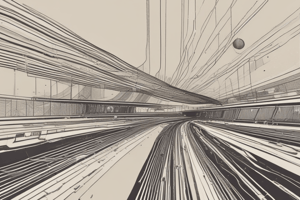Podcast
Questions and Answers
What does displacement represent in the context of motion in a straight line?
What does displacement represent in the context of motion in a straight line?
How far an object moves in a straight line from its initial location.
How is velocity defined in the context of motion in a straight line?
How is velocity defined in the context of motion in a straight line?
The rate of change of displacement with respect to time.
What symbol is used to represent acceleration in the context of motion in a straight line?
What symbol is used to represent acceleration in the context of motion in a straight line?
a or a_x
Why is displacement considered a vector quantity?
Why is displacement considered a vector quantity?
How can you describe velocity in terms of a moving car on a highway?
How can you describe velocity in terms of a moving car on a highway?
Define acceleration with respect to motion in a straight line.
Define acceleration with respect to motion in a straight line.
Define acceleration and explain why it is considered a vector quantity.
Define acceleration and explain why it is considered a vector quantity.
Differentiate between vector and scalar quantities with examples.
Differentiate between vector and scalar quantities with examples.
Explain the difference between instantaneous and average values for displacement, velocity, and acceleration.
Explain the difference between instantaneous and average values for displacement, velocity, and acceleration.
Calculate the acceleration of a car that goes from 20 m/s to 40 m/s in 5 seconds.
Calculate the acceleration of a car that goes from 20 m/s to 40 m/s in 5 seconds.
How would you mathematically represent the relationship between velocity, displacement, and time?
How would you mathematically represent the relationship between velocity, displacement, and time?
If an object's acceleration is negative, what does this indicate about its motion?
If an object's acceleration is negative, what does this indicate about its motion?
Flashcards are hidden until you start studying
Study Notes
Motion in a Straight Line: Displacement, Velocity, and Acceleration
Imagine a car driving down a highway, a ball rolling across a table, or a swimmer moving through a pool. These everyday scenarios all involve the concept of motion in a straight line, which is fundamental to understanding our physical world. To better grasp this concept, let's explore the key components: displacement, velocity, and acceleration.
Displacement
Displacement, symbolized as Δs (or simply s for small displacements), denotes how far an object moves in a straight line from its initial location. It's a vector quantity, meaning it has both magnitude and direction. Displacement is often measured in meters (m) or centimeters (cm).
For instance, if we mark the starting point of a ball on a table with an "A" and the final position with a "B," the displacement vector AB would indicate how far and in which direction the ball moved.
Velocity
Velocity, symbolized as v or v_x, is the rate of change of displacement with respect to time. It's a vector quantity, like displacement, and has both magnitude and direction. Velocity is often measured in meters per second (m/s) or centimeters per second (cm/s).
Consider the car driving down the highway, where the car's velocity would be the speed it's traveling and the direction it's headed in.
Acceleration
Acceleration, symbolized as a or a_x, is the rate of change of velocity with respect to time. Acceleration is also a vector quantity, and it has both magnitude and direction. Acceleration is often measured in meters per second squared (m/s²) or centimeters per second squared (cm/s²).
Let's return to our car example, where the driver might step on the gas pedal or brake, causing the car's velocity to change. In this case, acceleration is the rate at which the car's velocity changes.
Instantaneous and Average Values
These quantities can be measured as instantaneous values at a specific moment in time or as average values over a period of time, like the average velocity of an object over a certain interval.
Vector and Scalar Quantities
It's essential to recognize that displacement, velocity, and acceleration are vector quantities, which means they have both magnitude and direction. Scalar quantities, in contrast, only have magnitude (like distance, time, or mass).
Relationships Among Quantities
The relationship between these quantities can be represented with the following equations:
- Displacement (Δs) = final position - initial position
- Velocity (v) = Δs / change in time (Δt)
- Acceleration (a) = change in velocity (Δv) / change in time (Δt)
Examples
Let's consider a car traveling at 30 m/s (60 km/h) on a straight highway. After 10 seconds, the car's velocity increases to 40 m/s (80 km/h). The acceleration of the car is 1 m/s² (calculated as Δv/Δt = (40 m/s - 30 m/s) / 10 s = 1 m/s²).
Summary
To thoroughly understand motion in a straight line, one must grasp the concepts of displacement, velocity, and acceleration. These three quantities help us describe the motion of an object in a quantitative and qualitative way. Whether we're studying the movement of a car, a ball, or even our own bodies, these concepts provide a framework to describe and predict motion in a simple and efficient way.
Studying That Suits You
Use AI to generate personalized quizzes and flashcards to suit your learning preferences.



